Aquarium
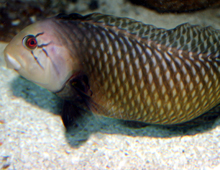
Dragon wrasse, Novaculichthys taeniourus
While juvenile and adult Harlequin tusk fish look very similar to each other, many other wrasses undergo astounding transformations as they reach maturity. As a juvenile, this Indo-Pacific species presents a dainty appearance, with a lacy-looking pattern and fins. The formidable adults are powerful fish that work in teams, taking turns lifting rocks and coral and grabbing the animals they find.
LEARN MORE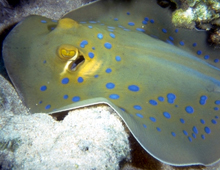
Blue-dot stingray, Taeniura lymma
The DWA exhibits an unusually extensive series of freshwater and saltwater stingrays. This inhabitant of coral reefs from the Red Sea to the Indo-Pacific is one of the most colorful of all elasmobranchs (sharks, rays, and chimeras). It is a small stingray, never more than three feet long, including its tail. It hunts crustaceans and other invertebrates.
LEARN MORE
Harlequin tuskfish, Choerodon fasciatus
This wrasse stands out in a family well known for garish patterns and colors. Its blue teeth accent the startling combination of red, white, and yellow. It can be found from Japan to Australia, where it is sometimes called a Macaw fish. Until the 1970s it was very rare in aquariums. For a large wrasse, it is rather well behaved in community displays.
LEARN MORE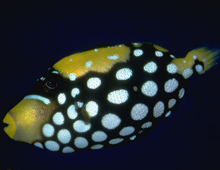
Clown triggerfish, Balistoides conspicillum
When this species first appeared in captivity more than 50 years ago, it created a sensation, and for years was known as “the most expensive aquarium fish”. Since the 1980s, it has been more frequently imported, but remains very popular. Unlike the Red-toothed triggerfish, it is an antisocial species that is never found in large numbers anywhere in its Indian Ocean and Indo-Pacific range. Triggerfish are named for the complicated structure of part of the dorsal fin, which “locks into place” so the fish can secure itself in crevices.
LEARN MORE
Red-toothed triggerfish, Odonus niger
One has to look closely at this elegant fish to see that its tiny but needle-sharp teeth are indeed a shade of dull pinkish red. This species does not have teeth as massive as most other triggerfishes, since it feeds primarily on plankton, often assembling in large schools to feast on it. It also eats sponges. Found from the Red Sea far into the Pacific, for many years it has been popular in aquariums, where it does very well.
LEARN MORE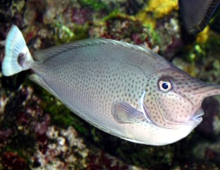
Unicorn tang, Naso unicornis
While many surgeonfish draw attention with brilliant colors, this gray fish stands out for its bizarre shape, appearing as if it had a “nose”. Feeding on algae and plankton in the wild, it enjoys lettuce and other leafy greens in aquariums. It can be found in schools from the Red Sea to many islands in the Pacific, including Hawaii, where it is a traditional food fish. Like other surgeonfish, it has defensive “scalpels” on its tail, but they are especially noticeable with this species because they are blue.
LEARN MORE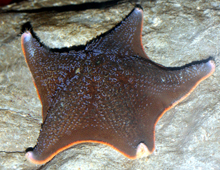
Bat starfish, Patiria miniata
Bat stars live on rocks, sand bottoms and surf grasses from British Columbia to Mexico. They are known to be omnivorous or scavengers and feed on a variety of plants and animals. To feed, the Bat star everts its stomach, wrapping it around its food to digest it. Like other echinoderms, the Bat star moves using tube feet pressurized by a water vascular system.
LEARN MORE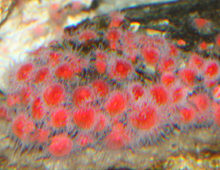
Strawberry anemone, Corynactis californica
The Strawberry anemone is a colonial invertebrate found in the temperate waters of the North American Pacific coast, from British Columbia to California. It feeds on small zooplankton such as copepods, capturing them in its stinging tentacles. Like other colonial invertebrates, the Strawberry anemone can reproduce by budding, which produces identical clones of each polyp. Clones of these anemones have been known to cover more than 10.8 square feet of the ocean floor.
LEARN MORE
Giant Pacific octopus, Enteroctopus dofleini
The Giant Pacific octopus is the largest species of octopus and has been known to reach sizes of 20-28 feet across and can weigh more than 100 pounds. The average arms span of an adult Giant octopus is about 15 feet. Like other species of octopus, the Giant octopus can secrete an ink screen to deter a predator and can inflict a venomous bite. They can change colors instantly, which is believed to communicate emotion.
LEARN MORE
Tiger rockfish, Sebastes negrocinctus
The Tiger rockfish is named for its striped coloration. The rockfish family is one of the largest fish families found in the temperate waters of the Pacific coast of North America. Its natural range extends from Alaska to Central California and it is known to be territorial and solitary. Many members of the rockfish family have venomous dorsal spines. The Tiger rockfish prefers to hide in rocky crevices and feeds on small crustaceans and fish.
LEARN MORE

